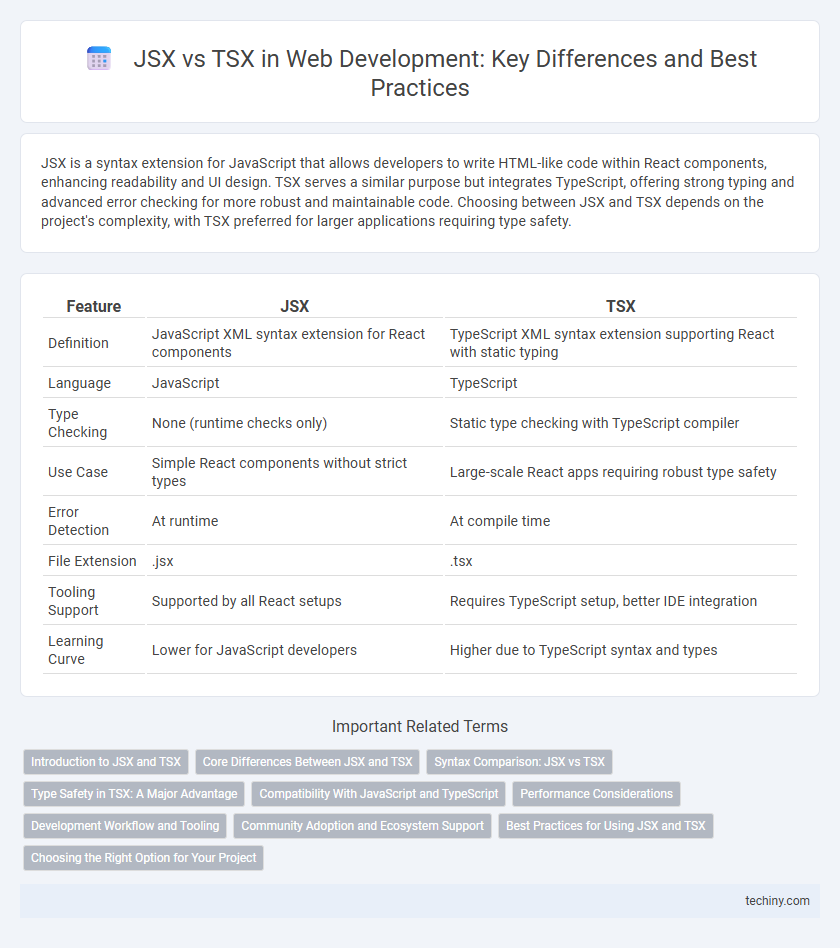JSX is a syntax extension for JavaScript that allows developers to write HTML-like code within React components, enhancing readability and UI design. TSX serves a similar purpose but integrates TypeScript, offering strong typing and advanced error checking for more robust and maintainable code. Choosing between JSX and TSX depends on the project's complexity, with TSX preferred for larger applications requiring type safety.
Table of Comparison
| Feature | JSX | TSX |
|---|---|---|
| Definition | JavaScript XML syntax extension for React components | TypeScript XML syntax extension supporting React with static typing |
| Language | JavaScript | TypeScript |
| Type Checking | None (runtime checks only) | Static type checking with TypeScript compiler |
| Use Case | Simple React components without strict types | Large-scale React apps requiring robust type safety |
| Error Detection | At runtime | At compile time |
| File Extension | .jsx | .tsx |
| Tooling Support | Supported by all React setups | Requires TypeScript setup, better IDE integration |
| Learning Curve | Lower for JavaScript developers | Higher due to TypeScript syntax and types |
Introduction to JSX and TSX
JSX (JavaScript XML) allows developers to write HTML-like syntax directly within JavaScript, enhancing the creation of React components with a clear and intuitive structure. TSX extends JSX by integrating TypeScript's static typing, enabling early error detection and improved code maintainability in React applications. Both JSX and TSX streamline UI development but TSX provides stronger type safety, making it essential for larger, scalable projects.
Core Differences Between JSX and TSX
JSX (JavaScript XML) is a syntax extension for JavaScript that enables writing HTML-like code within JavaScript, primarily used in React for UI creation. TSX (TypeScript XML) extends JSX by integrating TypeScript's static type checking, allowing developers to catch type errors during development and enhancing code reliability. The core difference lies in TSX's support for TypeScript features such as interfaces, types, and advanced autocompletion, which are not available in plain JSX.
Syntax Comparison: JSX vs TSX
JSX (JavaScript XML) syntax enables embedding HTML-like code within JavaScript, facilitating the creation of React components with ease. TSX extends JSX by incorporating TypeScript's static typing and interfaces, improving code reliability and developer experience. The main syntactical difference lies in TSX's support for type annotations, making props and state more explicit compared to JSX's dynamic typing.
Type Safety in TSX: A Major Advantage
TSX enhances type safety by integrating TypeScript's static typing directly within JSX syntax, reducing runtime errors and improving code reliability. Developers benefit from early detection of type mismatches, which streamlines debugging and accelerates development cycles in React applications. This robust type assurance leads to more maintainable and scalable web projects compared to traditional JSX usage.
Compatibility With JavaScript and TypeScript
JSX offers seamless compatibility with JavaScript, allowing developers to write HTML-like syntax directly within JavaScript code, which enhances code readability and simplifies UI component creation. TSX extends JSX by incorporating TypeScript's static typing features, providing improved type safety and error checking during development without sacrificing compatibility with existing JavaScript libraries. Both JSX and TSX enable efficient integration with modern JavaScript frameworks, but TSX is preferred for projects requiring robust type systems and scalable codebases.
Performance Considerations
JSX and TSX both serve as syntactic extensions for JavaScript that enable writing XML-like code for React components, with TSX adding TypeScript's static type checking for improved code quality. Performance differences between JSX and TSX are minimal at runtime because both compile down to nearly identical JavaScript code; however, TSX enhances development performance by catching errors early and improving tooling support. Optimizing performance primarily depends on React rendering techniques and component architecture rather than the choice between JSX and TSX.
Development Workflow and Tooling
JSX and TSX both streamline development workflows by enabling seamless integration of JavaScript and TypeScript with React components, but TSX enhances static type checking and error detection during coding. TSX's compatibility with TypeScript tooling like Visual Studio Code, TypeScript Language Server, and ESLint improves code quality and maintenance through better autocomplete, refactoring, and debugging capabilities. Development environments leveraging TSX benefit from early bug identification and improved developer productivity compared to JSX.
Community Adoption and Ecosystem Support
JSX, primarily associated with React, enjoys widespread community adoption and extensive ecosystem support through plugins, libraries, and tools that streamline component development. TSX extends JSX by integrating TypeScript, enhancing type safety and developer productivity, which has led to rapid adoption among enterprises prioritizing scalable, maintainable codebases. The growing ecosystem of TypeScript-compatible libraries and frameworks bolsters TSX's appeal, making it a preferred choice for developers seeking robust typing along with React's declarative UI patterns.
Best Practices for Using JSX and TSX
JSX and TSX both serve as syntactic extensions for JavaScript and TypeScript, enabling the integration of HTML-like code within React components. Best practices for using JSX involve writing clear and concise components, utilizing prop types for type checking, and maintaining separation of concerns by avoiding inline styles or heavy logic within JSX. When working with TSX, leveraging TypeScript's static type system improves code reliability, enforces stricter type safety for component props and state, and enhances developer experience through autocompletion and error detection during compilation.
Choosing the Right Option for Your Project
JSX offers a straightforward syntax for embedding HTML within JavaScript, ideal for projects prioritizing simplicity and rapid development. TSX extends JSX by integrating TypeScript's static typing, enhancing code reliability and maintainability in large-scale or complex applications. Selecting between JSX and TSX depends on the project's complexity, team size, and long-term scalability requirements, with TSX providing stronger type safety and improved developer tooling.
JSX vs TSX Infographic

 techiny.com
techiny.com